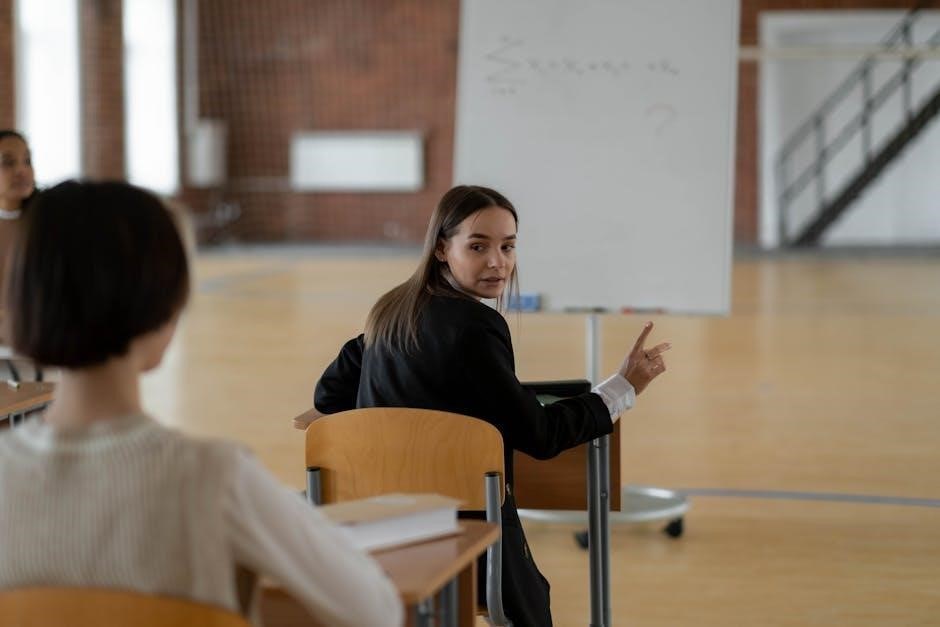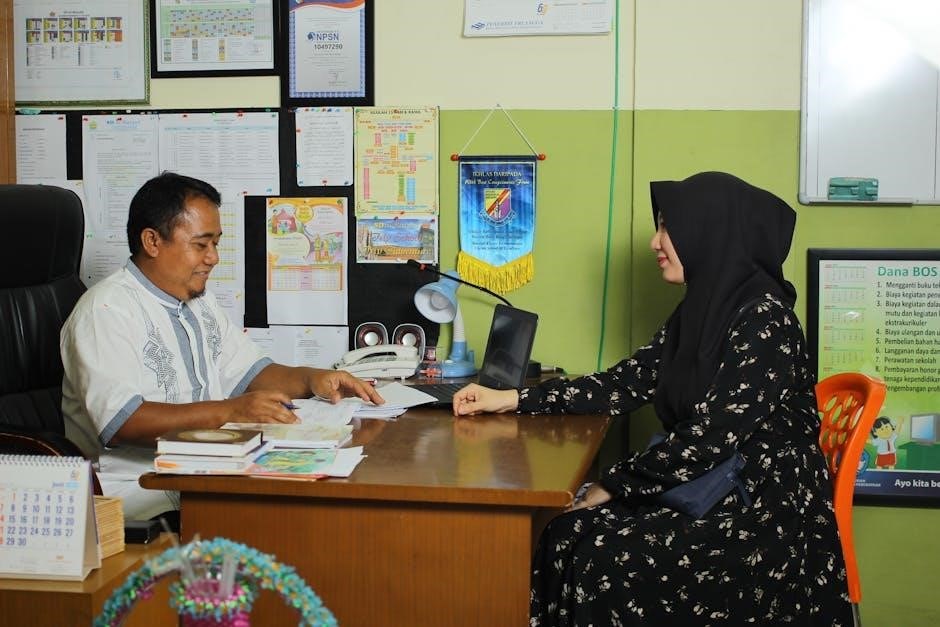Parent-teacher meetings foster collaboration between educators and parents, focusing on student progress, challenges, and goals. They provide a structured platform for open communication, ensuring mutual understanding and support.
Importance of Parent-Teacher Meetings
Parent-teacher meetings are crucial for fostering collaboration between educators and parents, ensuring a unified approach to a child’s education. They provide a platform to discuss progress, address concerns, and set goals, promoting a supportive learning environment. These meetings help parents understand their child’s strengths, weaknesses, and academic performance, enabling them to support their child effectively. Regular communication builds trust and ensures both parties are aligned in helping the student succeed. By addressing challenges early, meetings contribute to improved academic and social outcomes. They also empower parents to take an active role in their child’s education, reinforcing the importance of partnership between home and school. Ultimately, parent-teacher meetings are essential for fostering growth and ensuring students receive the support they need to thrive.

Objectives of Parent-Teacher Conferences
Parent-teacher conferences aim to establish clear communication between educators and parents, ensuring alignment on a child’s educational journey. Key objectives include understanding the student’s academic progress, identifying strengths and weaknesses, and addressing any challenges or concerns. These meetings also focus on setting realistic goals, fostering collaboration, and involving parents in their child’s learning process. By sharing insights and resources, conferences help create a supportive environment for student growth. Additionally, they provide an opportunity to discuss behavioral and social development, ensuring a holistic approach to education. The ultimate goal is to empower both parents and teachers with the tools and information needed to help students achieve their full potential.

Preparation for the Meeting
Preparation for parent-teacher meetings is crucial for both teachers and parents. Teachers should review records, prepare materials, and outline discussion points. Parents should gather questions and concerns.
Checklist for Teachers
- Review student records, progress reports, and recent assignments to provide accurate feedback.
- Prepare a list of strengths, weaknesses, and specific examples to discuss.
- Identify key discussion points, such as academic performance, behavior, and social development.
- Organize materials like report cards, test scores, and work samples for reference.
- Develop questions to ask parents about their child’s home environment and interests.
- Create a positive and welcoming tone to encourage open communication.
- Prepare an agenda to guide the conversation and ensure all topics are covered.
- Plan strategies or recommendations to support the student’s improvement.
- Have a notepad and pen ready to take notes and provide a summary afterward.
Preparation ensures the meeting is productive and focused on the student’s success.
Checklist for Parents
Parents should prepare thoroughly for parent-teacher meetings to maximize the discussion’s effectiveness. Review your child’s recent assignments, test scores, and progress reports to understand their academic standing. Identify specific questions or concerns to address during the meeting, such as your child’s strengths, challenges, or social interactions. Consider your child’s behavior and attitudes at home to share insights that might help the teacher. Consider any changes in your child’s life that could impact their performance or well-being. Prepare a list of goals or expectations you have for your child and be ready to collaborate with the teacher. Bring any additional materials, like report cards or feedback from tutors, if relevant. Arrive early and be open to feedback and suggestions. This preparation ensures a productive and meaningful conversation about your child’s success.
Reviewing Student Records and Progress
Reviewing student records and progress is essential for a productive parent-teacher meeting. Teachers typically prepare by examining report cards, test scores, and progress reports to identify trends in academic performance. Parents should also review these documents to understand their child’s strengths and areas needing improvement. Discussing social interactions, behavior, and participation in class helps provide a holistic view of the student’s development. This step ensures that both parties are well-informed and aligned on the child’s current standing. By focusing on factual data, the conversation remains objective and centered on the student’s needs. This preparation also allows for identifying specific challenges or successes to address during the meeting, ensuring a collaborative approach to supporting the child’s growth.

Key Points to Discuss
Key points include the student’s strengths, weaknesses, academic progress, behavior, and social development. These discussions help identify areas needing support and set actionable goals for improvement.
Student’s Strengths and Weaknesses
Discussing a student’s strengths and weaknesses is crucial for understanding their overall development. Teachers should highlight specific areas where the student excels, such as academic skills, creativity, or leadership, while also identifying challenges like difficulty with certain subjects or social interactions. Parents can share insights from home, providing a holistic view of the child’s abilities. This collaborative approach ensures both parties are aligned in supporting the student’s growth.
Using checklists or templates, teachers can organize key points, ensuring a balanced and factual discussion. Parents can ask questions like, “What are my child’s strengths and weaknesses?” to gain clarity. This dialogue helps create personalized strategies to build on strengths and address weaknesses, fostering a supportive learning environment.
Academic Performance and Progress
Discussions about academic performance and progress are central to parent-teacher meetings. Teachers should provide factual information, such as test scores, grades, and project results, to give parents a clear picture of their child’s achievements. This includes highlighting improvements over time and identifying areas where the student may need additional support. Specific examples, like excelling in math problem-solving or struggling with reading comprehension, help parents understand their child’s academic standing. Teachers should also share insights into the student’s work habits, such as completion of assignments and participation in class.
By focusing on measurable progress and specific challenges, parents and teachers can collaborate to set realistic goals and develop strategies to help the student succeed. This ensures the meeting is productive and aligned with the child’s educational journey.
Behavior and Social Development
Discussions about a student’s behavior and social development are crucial for understanding their overall growth. Teachers should share observations on how the child interacts with peers, demonstrates empathy, and resolves conflicts. Highlighting positive behaviors, such as leadership or kindness, helps parents recognize their child’s strengths. Conversely, addressing challenges like shyness or impulsivity provides insight into areas needing support. Teachers should also discuss the child’s ability to follow classroom rules and respect boundaries. Parents and teachers can collaborate to reinforce positive behavior and develop strategies for social skills improvement. This dialogue ensures a well-rounded approach to the child’s development beyond academics. By focusing on social growth, parents and educators can help the child build strong relationships and emotional resilience. This fosters a supportive environment for their overall well-being.
Homework and Study Habits
Discussing homework and study habits helps parents and teachers understand how a child manages academic responsibilities outside the classroom. Teachers can share insights into the quality and consistency of completed assignments, highlighting areas where the child excels or needs improvement. Parents should inquire about the types of homework assigned and how it aligns with the child’s learning goals. It’s important to address study habits, such as time management, organization, and focus, to ensure the child is developing effective skills for long-term success. Teachers and parents can collaborate to establish routines or strategies that promote better habits, such as designating a quiet study space or breaking tasks into manageable steps. Open dialogue about homework challenges and successes fosters a supportive environment for the child’s academic growth. Consistent communication ensures both parties are aligned in helping the child thrive.

Strategies for Effective Communication
Effective communication involves active listening, asking open-ended questions, and sharing factual information to build trust and collaboration between parents and teachers.
Active Listening Skills
Active listening is crucial during parent-teacher meetings. It involves fully concentrating on the speaker, understanding their perspective, and responding thoughtfully. Teachers should avoid interrupting and instead nod or use verbal cues like “I see” to show engagement. Parents should also listen attentively to the teacher’s insights, asking clarifying questions to ensure understanding. This mutual respect fosters a collaborative environment, allowing both parties to address the student’s needs effectively. By actively listening, both educators and parents can build trust and work together to support the child’s development. This approach ensures that concerns are addressed constructively and solutions are mutually agreed upon.
Asking Open-Ended Questions
Asking open-ended questions during parent-teacher meetings encourages meaningful dialogue and provides deeper insights into a student’s progress. Teachers and parents should avoid yes/no questions and instead ask questions that prompt detailed responses. For example, “What strategies do you think could help your child improve in math?” or “How does your child approach homework at home?” These questions allow both parties to share perspectives and explore solutions collaboratively. Open-ended questions foster a more engaging and productive conversation, ensuring that both the teacher and parent gain a comprehensive understanding of the student’s strengths, challenges, and needs. This approach helps in creating a supportive plan for the student’s growth and development.
Sharing Factual Information
Sharing factual information is a cornerstone of productive parent-teacher meetings. Teachers should present data on a student’s academic performance, such as test scores, grades, and progress reports. This information helps parents understand their child’s current standing and identifies areas needing improvement. Factual data also includes observations of the student’s behavior, participation, and social interactions. Teachers should provide specific examples to support their points, ensuring clarity and objectivity. This approach fosters trust and collaboration, as parents can see the evidence behind the feedback. By focusing on verifiable information, the conversation remains constructive and centered on the student’s well-being and growth. Sharing factual information ensures that both parties are aligned and working toward common goals for the student’s success.

Setting Goals and Expectations
Setting goals involves collaboration between teachers and parents to create a tailored plan for the student’s success. Aligning expectations ensures a clear path for growth.
Short-Term and Long-Term Goals
Establishing clear objectives is crucial for student success. Short-term goals focus on immediate improvements, such as completing homework consistently or raising test scores. These are achievable within a few weeks to months. Long-term goals, however, envision broader development, like mastering a subject or improving social skills over a year. Both types of goals should be specific, measurable, and aligned with the student’s overall progress. Collaborative goal-setting ensures that teachers, parents, and students work together towards these targets, fostering accountability and motivation. Regular assessments help track progress, allowing adjustments as needed to keep the student on the right path. This structured approach ensures steady growth and lasting success.
Collaborative Goal Setting
Collaborative goal setting involves teachers, parents, and students working together to create achievable objectives. This approach ensures that everyone is aligned and committed to the student’s success. By sharing perspectives, teachers can provide academic insights, while parents offer valuable information about their child’s needs and motivations. Students also gain a sense of ownership by participating in the process. Open communication and mutual respect are key to effective collaboration. Setting realistic expectations and breaking larger goals into smaller steps helps maintain focus and momentum. Regular follow-ups and adjustments keep everyone accountable and ensure the goals remain relevant. This teamwork not only enhances student outcomes but also strengthens the home-school partnership, creating a supportive environment for growth.

Addressing Concerns and Challenges
Addressing concerns involves identifying academic or behavioral issues and developing strategies to support the student. Open dialogue fosters a collaborative approach to resolving challenges effectively.
Identifying Academic Difficulties
Identifying academic difficulties involves analyzing the student’s performance in specific subjects or skills. Teachers review grades, test scores, and assignments to pinpoint areas where the student may be struggling. Open communication with parents helps understand the child’s learning challenges and develop targeted strategies for improvement. Discussing these difficulties allows both teachers and parents to align their efforts, creating a supportive environment for the student. This collaborative approach ensures that the child receives the necessary resources and guidance to overcome obstacles and achieve their academic potential.
Addressing Social or Emotional Challenges
Addressing social or emotional challenges involves understanding the student’s behavior and emotional well-being. Teachers and parents collaborate to identify signs of distress, such as anxiety or difficulties in social interactions. Open discussions help uncover underlying issues, fostering a supportive environment for the student. Sharing strategies and resources, like counseling services or behavioral interventions, ensures consistent support at home and school. This partnership helps the student develop emotional resilience and social skills, promoting overall well-being and academic success.

Follow-Up and Next Steps
After the meeting, create an action plan with specific steps for both parents and teachers. Assign tasks, set deadlines, and schedule a follow-up meeting to review progress.
Creating an Action Plan
Developing a clear action plan is crucial for addressing student needs post-meeting. Teachers and parents should collaborate to outline specific, measurable goals. These may include academic interventions, behavioral strategies, or additional resources. Assign responsibilities to ensure accountability, with timelines for completion. Regular check-ins, such as progress reports or follow-up meetings, help monitor advancements. Documenting the plan provides a reference for both parties, fostering transparency and commitment. By aligning efforts, educators and parents create a unified approach to support the student’s success. This structured plan not only addresses immediate concerns but also sets the stage for long-term growth and development. Clear communication and mutual agreement are key to its effectiveness.
Scheduling Follow-Up Meetings
Scheduling follow-up meetings ensures continuous monitoring of student progress and adjusts strategies as needed. Agree on specific dates and times that suit both parents and teachers, using shared calendars or digital tools for organization. These meetings provide opportunities to review the action plan’s effectiveness, celebrate successes, and address any emerging challenges. Regular follow-ups help maintain momentum and reinforce collaboration between home and school. Clear communication about the purpose and expected outcomes of each meeting ensures all parties remain aligned. By prioritizing follow-ups, educators and parents demonstrate a commitment to the student’s ongoing development and well-being. Consistency in scheduling fosters trust and supports the achievement of both short-term and long-term goals.

Tools and Resources
Utilize meeting templates, checklists, and digital platforms to organize discussions and track progress. Sharing educational resources and tools enhances collaboration and supports student development effectively.
Using Meeting Templates and Checklists
Meeting templates and checklists are essential tools for organizing and structuring parent-teacher discussions. They ensure that all key points, such as student strengths, achievements, and areas for improvement, are covered. Templates often include sections for setting goals, reviewing progress, and outlining next steps, helping to keep the conversation focused and productive. Checklists can be used by both teachers and parents to prepare for the meeting, ensuring that no important topics are overlooked. These resources also provide a clear format for documenting decisions and follow-up actions, making it easier to track progress over time. By using these tools, meetings become more efficient, and both parties can leave with a shared understanding of the student’s needs and plans for support.

Sharing Educational Resources
Sharing educational resources during parent-teacher meetings is a valuable way to support student learning. Teachers can provide parents with recommended materials, such as worksheets, reading lists, or digital tools, to reinforce classroom lessons at home. These resources can help address specific academic or behavioral needs and ensure consistency between school and home environments. Parents can also share resources they find helpful, fostering a collaborative approach to education. By exchanging these tools, both parties can work together to create a personalized learning plan tailored to the student’s needs. This mutual exchange not only enhances the student’s academic journey but also strengthens the partnership between educators and families.
Parent-teacher meetings foster a partnership between educators and parents, ensuring collaborative support for students. They provide a platform to discuss progress, address challenges, and align efforts for the child’s success.
Reviewing Key Takeaways
At the end of the meeting, summarizing key points ensures clarity and alignment. Both parties should agree on the main discussion points, such as the child’s strengths, areas needing improvement, and actionable steps. This helps in maintaining focus and accountability. Parents and teachers should leave with a clear understanding of their roles in supporting the student. Reviewing key takeaways also ensures that any agreed-upon goals or interventions are well-documented. This step is crucial for tracking progress and maintaining open communication. By revisiting the main points, both parties can reinforce their commitment to the child’s education and development.
Signatures and Documentation
Documentation is a critical aspect of parent-teacher meetings, ensuring accountability and clarity. A signed record of the discussion, including key points, agreements, and action plans, serves as a formal acknowledgment. Both parents and teachers should sign the document, confirming their understanding and commitment. This practice helps maintain transparency and provides a reference for future follow-ups. Templates often include sections for signatures, strengths, achievements, and follow-up actions. Proper documentation also aids in tracking progress over time. By formalizing the discussion, all parties can revisit the agreed-upon goals and ensure consistent support for the student’s growth and development.





